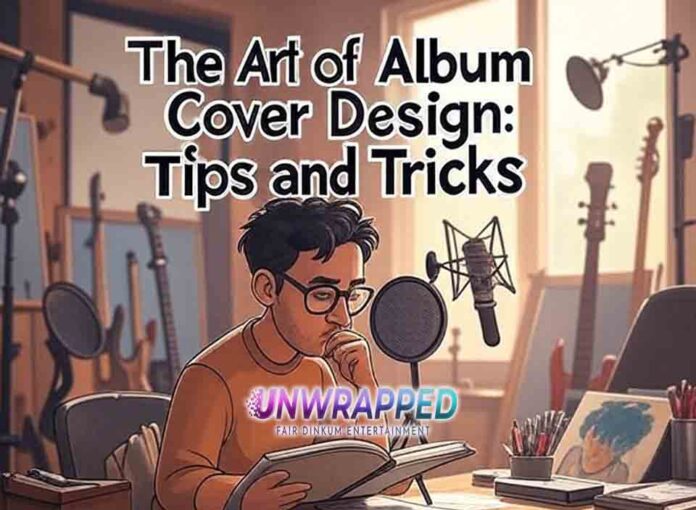Album covers are more than just packaging—they’re a visual gateway into the music itself. In an era dominated by streaming services and digital downloads, an album’s cover still plays a vital role in shaping first impressions, telling a story, and defining a musician’s brand. Some of the most iconic images in pop culture history—from Pink Floyd’s prism to Nirvana’s underwater baby—were born from album covers that perfectly fused sound with visual expression.
Designing an effective album cover is a delicate balance between art, marketing, and emotional impact. Whether for a debut indie release or a major label drop, a powerful cover can attract listeners, build identity, and even become timeless. This guide explores the art of album cover design—sharing essential tips, proven tricks, and creative insights to help designers and musicians create compelling, high-impact visuals.
Why Album Cover Design Still Matters
Despite shrinking physical sales, album art is far from obsolete. Platforms like Spotify, Apple Music, Bandcamp, and YouTube still rely heavily on cover imagery to visually represent the music. These thumbnails are often the first—and sometimes only—thing listeners see.
Key roles of a great album cover:
Captures attention in crowded feeds
Establishes artist branding and aesthetic
Enhances storytelling or concept of the album
Creates emotional resonance before the first note plays
In short, the album cover is the music’s visual handshake—and it better be memorable.
1. Understand the Album’s Message and Mood
Before opening Photoshop or sketching concepts, it’s crucial to understand the essence of the music. Is it moody and introspective? Loud and rebellious? Playful and retro?
Start with these steps:
Listen to the full album or EP multiple times
Note recurring themes, lyrics, or moods
Ask the artist about their inspiration or vision
Identify genre conventions, then decide whether to follow or challenge them
The design should visually mirror the sonic tone. For example, a minimalist black-and-white design might suit a lo-fi indie album, while bold neon might scream electro-pop.
People Also Love: The Growth of DIY Music Production Among Amateurs
2. Prioritize Simplicity and Scalability
Today’s music lives primarily on screens—often tiny ones. That stunning full-size artwork may lose all detail as a thumbnail. Good album design works across formats: vinyl sleeves, CD inserts, Spotify tiles, YouTube thumbnails, and Instagram posts.
Tips for scalable design:
Use clear focal points (avoid overly busy compositions)
Ensure readable typography even at small sizes
Test visibility at multiple resolutions (300x300px, 600x600px, 1400x1400px)
Keep the color palette bold and cohesive
3. Choose Typography That Speaks the Language of the Music
Fonts are just as emotional as images. The typography should complement—not compete with—the artwork, while also giving clues about the music style.
Examples of typography mood matching:
Sans-serif fonts for modern or electronic music
Handwritten or grunge fonts for alternative or punk
Classic serif fonts for jazz or singer-songwriter genres
No text at all for abstract or experimental works
Make sure font placement and size work well across different viewing sizes. If using band or album names, consider how they’ll appear on platforms that auto-crop artwork into circles or squares.
4. Use Imagery That Tells a Story or Sparks Emotion
Iconic album art often hinges on striking imagery—whether photography, illustration, collage, or digital manipulation. The key is to create something that either:
Tells a story
Triggers an emotional response
Reflects the lyrical themes or title
Embodies the sonic aesthetic
Don’t shy away from abstract visuals if they fit the vibe. Think of Radiohead’s Kid A or Kanye West’s Yeezus—covers that say everything by saying almost nothing.
5. Embrace Negative Space and Balance
Just like silence in music, negative space in design adds power. It helps draw the eye to focal points and creates a sense of structure.
Balance Tips:
Align visual elements using the rule of thirds
Avoid cluttering all four corners—give elements breathing room
Use background color or texture as a balancing tool
Don’t overuse filters or overlays that muddy the image
This is especially important for digital music platforms, where too much detail becomes noise.
6. Think Beyond the Cover—Design for a Full Visual Identity
An album cover doesn’t live in isolation. It becomes the face of social media posts, press kits, tour posters, merch, lyric videos, and more.
Design with cohesion in mind:
Create a color palette and font set to use across digital assets
Develop variants for banners, square posts, and profile icons
Consider animated versions for social platforms or streaming sites
Artists like Tyler, the Creator and Billie Eilish are known for crafting entire visual worlds around each album era—turning the album art into a brand.
7. Learn from the Greats: Study Iconic Album Art
Analyzing successful covers can sharpen design instincts. Look at both critically acclaimed and commercially successful examples to understand what worked and why.
Classic examples:
The Velvet Underground & Nico (Andy Warhol’s banana)
Pink Floyd – Dark Side of the Moon (geometric simplicity)
Nirvana – Nevermind (shock value meets cultural commentary)
Kendrick Lamar – DAMN. (typography-led minimalism)
Each cover offers a case study in balancing art with identity.
Another Must-Read: Top South African Music Festivals in 2025
8. Don’t Underestimate the Power of Collaboration
If you’re not a designer, hire one or collaborate. Many great album covers are born from a deep creative partnership between the artist and designer.
Tips for working with a designer:
Provide a creative brief: genre, tone, references, intended platforms
Share demos or finalized tracks
Be open to concept sketches and feedback loops
Consider budgeting for both static and animated versions
Sites like Behance, 99Designs, and Fiverr are great places to discover freelance talent.
9. Technical Specs You Need to Know
When it’s time to upload, different platforms have different specs.
Standard file guidelines:
Size: 3000×3000 pixels (minimum 1400×1400 for Spotify)
Format: JPG or PNG
Color: RGB (not CMYK)
Resolution: 72–300 DPI (300 preferred for print)
No explicit logos or copyright images
10. Tools and Platforms for DIY Design
Not a pro designer? No problem. There are accessible platforms that allow musicians and indie labels to create beautiful covers with no formal training.
Top tools to try:
Canva: Pre-made templates, drag-and-drop interface
Adobe Express: Simplified version of Adobe Creative Suite
Fotor: Online photo editor and album cover maker
Placeit: Album cover mockups and social templates
While templates are helpful, always try to customize with your own fonts, images, or textures to avoid generic results.
Call to Action: Design with Purpose, Not Just Aesthetic
Creating a great album cover isn’t about jumping on trends or mimicking what’s popular. It’s about designing a visual that honors the music, connects with your audience, and builds a lasting impression. Take time to listen, explore, test, and iterate. The extra effort shows—and it lasts far beyond the release date.
Share this article with fellow artists, musicians, and designers, and start building cover art that tells your music’s story before a single lyric is heard.
Conclusion
The album cover is more than a square graphic—it’s a visual signature. In a saturated music market, powerful design can make the difference between a scroll-past and a play. From mood matching and scalability to typography and storytelling, each design element works together to create a compelling invitation into your sonic world.
For emerging artists and seasoned pros alike, embracing the art of album cover design isn’t just smart marketing—it’s an opportunity to make your sound seen. Done right, it becomes a piece of the music’s legacy.
See Also: How to Build a Successful Music Career Independently










